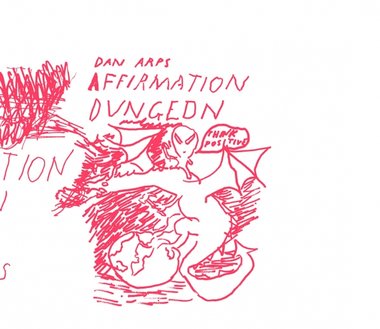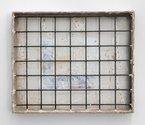John Hurrell – 4 July, 2012
The jumbled order of the images deliberately reflects the dice throwing of the role-playing game Dungeons & Dragons, an important theme that is referred to in the title and in the content of two of the articles. One - Melan's contribution, ‘Dungeon Mapping' - is well illustrated with map prototypes to bring a level of conceptual layering to Arps' practice in terms of exhibition and career strategy: a God's eye view of the zigzagging pathways and adopted roles an ambitious artist needs to take.
Dan Arps
Affirmation Dungeon
Essays by Jon Bywater, Aitken, Matthew Hyland, Melan, Narelle Pathways
Edited by Gwynneth Porter
Designed by Warren Olds
335 pp hardcover
Michael Lett /Clouds 2012
Affirmative Dungeon follows in the footsteps of earlier Arps exhibition publications like Gestapo Pussy Ranch with its humour, hybrid printing methods and oddly juxtaposed (or blended) writing styles. The earlier catalogue was a magazine-like pamphlet. This book though is a serious tome: hardcover, weighty (bodily and intellectually), elegant looking and thick.
To accompany approximately 300 coloured illustrations of components from various Arps exhibitions (their pagination randomly shuffled) - with captions provided at the back that use miniature b/w versions in the same sequence - Arps and Porter (the editor) have selected six bodies of writing.
The jumbled order of the images deliberately reflects the dice throwing of the role-playing game Dungeons & Dragons, an important theme that is referred to in the title and in the content of two of the articles. One - Melan’s contribution, ‘Dungeon Mapping’ - is well illustrated with map prototypes to bring a level of conceptual layering to Arps’ practice in terms of exhibition and career strategy: a God’s eye view of the zigzagging pathways and adopted roles an ambitious artist needs to take.
The other related article, ‘”The Dungeon 100” Areas for us to work on’, lists various grammatical structures and parts of speech to be studied. It is as if Arps correlates various computer-driven processes with systems such as the transitive verb lists of Serra or written drawings of Smithson, or the way he makes objects or drawings with fascinatingly ugly manual marks and inventive juxtapositions.
Another major theme of the book is the Foucauldian notion of biopower, the governmental control of group behaviour, connecting it to the sort of mock-institutional spaces or dinky shelters Arps specialises in creating within his installations. Included is a set of nine stapled sheets from The Bio-Power Digest (Volumes 2-4) put out by Matthew Hyland, most of which appeared in the first issue of Natural Selection. They present various examples of workplace stress or pathologies, forms of monitoring / surveillance and case studies. A sort of ‘believe it or not’ approach to more extreme examples of management/worker relations.
The two dominant texts come from Jon Bywater amd Narelle Pathways. Pathways’ ‘Rental Property’ is the clearer of the two, describing the crushing mental impact (during the current recession) of institutional spaces such as Auckland WINZ offices, and the structuring of information in psychoanalytical/therapy flow-diagrams like those of Wilhelm Reich.
Bywater’s ‘Life-Work Balance’ essay (which first appeared in Reading Room 3) is valuable because it looks closely at the use of space in Arps’ exhibitions, the details of his hybrid components and how they can be interpreted. It presents an argument that despite being commodifiable, Arps’ practice undermines the capitalist ethos. Starting with Adorno and then Williams and Jameson, Bywater examines the much aired point that contemporary art’s infatuation with novelty reflects its alignment with capitalism, akin to the complicity of the fashion industry.
Elaborating on an argument by Giorgio Agamben that ‘the sphere of gestures or pure means (means emancipated from their relation to an end)’ is ‘the proper sphere of politics’, and that ‘cinema leads images back to the homeland of gesture’, Bywater sees a connection between gesture here and the types of ‘unlaboured’ defacing marks Arps revels in, what he describes as deliberately ‘indulgent’, lazy, childish, not craft-intensive’.
Bywater’s linking of Arps with Agamben puzzles me because Arps’ ubiquitous wipes are static, not related to film, and much of his sculpture is craft-intensive. He is wildly imaginative in his radical and comical blending of oddball materials, and in sculpture, a virtuoso in casting and mould-making - with a practice that furtively hides its industriousness and talent. It is a mistake I think to claim as Bywater does that his marks have a ‘consistent tone…that frees effort from the effortful, the un-laboured’ (p.300) and that these are continuum of a readymade-based ethos. That ‘effortlessness’ is clearly one winking gag amongst many, and his readymades are usually ‘assisted’ (to use Duchamp’s term), and blended with demonstrations of craft-based skill.
Some commentators point out that Agamben in his ‘sphere of gestures’ refers to a certain variety of movement found in the ‘spasmodic jerks’ of Tourette’s syndrome, a neural disease discovered by Gilles de la Tourette. Arps’ static ‘gestures’ are (I think) quite different. They are knowing, calculated to disturb as snotty or faecal smears, made by an artist fully in control, one who is theatrical but not cinematic in his thinking.
This is in contrast to Martin Creed who in a ‘Fuck off’ music video makes what Goldmiths’ theory blogger Amy P considers to be a good example of Agamben’s notion. She also refers to Massimiliano Gioni’s catalogue essay in Creed’s book Works. In this text Gioni considers that Creed works like his Shit and Sick films allude to a body as ‘a machine…trapped in an infinite repetition of gestures’ (p.xxi).
There is no such markmaking process in Arps. There are works with random smears but they are not machine-like. They are provocative wipes. Arps (and Creed’s films too I think) is more linked to Bataille’s concept of the formless as discussed by Krauss and Bois. They are too organic to be mechanical. It is a different sort of process.
I think the cover of this book, a red-lined drawing of a dragon holding the world in its claws, about to smash it with a hammer and with an alien on its back exhorting it to ‘think positive’, says something about this reduction of the vertical to the horizontal. It is drawn with a relaxed fluidity yet is thought out well before execution. Not ‘lazy’ or ‘childish’ the thinking is obviously humorous, sophisticated and ironic, anticipating an appreciative audience that will enjoy the different stacked up levels, of which the informe is one.
Arps is a clever, complicated, multi-layered artist and this unusual publication shrewdly reflects that complexity. For him and Clouds, it is a significant achievement.
John Hurrell


 Two Rooms presents a program of residencies and projects
Two Rooms presents a program of residencies and projects Advertising in this column
Advertising in this column



This Discussion has 0 comments.
Comment
Participate
Register to Participate.
Sign in
Sign in to an existing account.